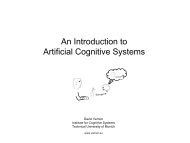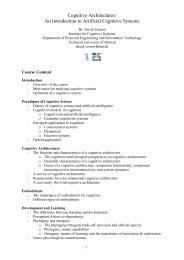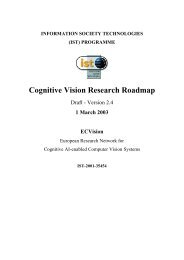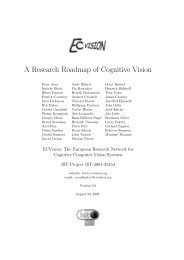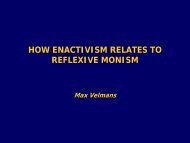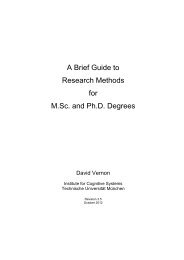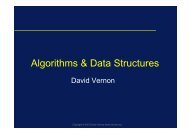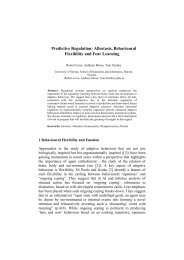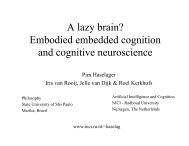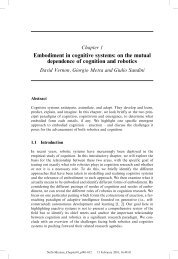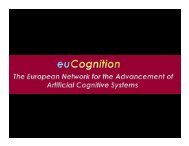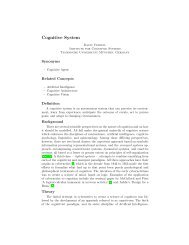Dynamic Field Theory (DFT): Applications in Cognitive Science and ...
Dynamic Field Theory (DFT): Applications in Cognitive Science and ...
Dynamic Field Theory (DFT): Applications in Cognitive Science and ...
You also want an ePaper? Increase the reach of your titles
YUMPU automatically turns print PDFs into web optimized ePapers that Google loves.
<strong>Dynamic</strong> <strong>Field</strong> <strong>Theory</strong> (<strong>DFT</strong>):<br />
<strong>Applications</strong> <strong>in</strong> <strong>Cognitive</strong> <strong>Science</strong> <strong>and</strong> Robotics<br />
Wolfram Erlhagen 1 <strong>and</strong> Estela Bicho 2<br />
1 Dep. of Mathematics for S&T, 2 Dep. of Industrial Electronics<br />
University of M<strong>in</strong>ho, Portugal<br />
(wolfram.erlhagen@mct.um<strong>in</strong>ho.pt, estela.bicho@dei.um<strong>in</strong>ho.pt)<br />
Introduction<br />
In recent years, there has been an <strong>in</strong>creas<strong>in</strong>g <strong>in</strong>terest <strong>in</strong> the dynamical systems approach<br />
to cognitive science that challenges the more traditional, computational view on<br />
cognition ([1], [2], [3]). The heart of the dynamic approach is the hypothesis that natural<br />
cognition embedded <strong>in</strong> a nervous system <strong>and</strong> <strong>in</strong> an environment unfolds cont<strong>in</strong>uously <strong>in</strong><br />
time as the result of the complex <strong>in</strong>terplay between a variety of <strong>in</strong>ternal <strong>and</strong> external<br />
forces. Proponents of this new direction argue that cognitive processes can be<br />
conceptualized <strong>in</strong> terms of position, distance <strong>and</strong> trajectories <strong>in</strong> the space of possible<br />
states of the system. Consequently, the primary focus of their theoretical <strong>and</strong> empirical<br />
research program is on underst<strong>and</strong><strong>in</strong>g the nature of change <strong>in</strong> time. The dynamic<br />
hypothesis strongly contrasts with the computational approach that expla<strong>in</strong>s cognitive<br />
behaviour as a rule-based manipulation of static <strong>in</strong>ternal representations.<br />
The theory of nonl<strong>in</strong>ear dynamical systems is the mathematical framework that<br />
offers essential concepts <strong>and</strong> tools such as attractor, repeller, stability, bifurcation,<br />
trajectory <strong>in</strong> state space <strong>and</strong> the like. However, these concepts are certa<strong>in</strong>ly necessary<br />
but not sufficient for a dynamical systems approach to higher cognitive capacities. The<br />
problem is that flexible <strong>and</strong> <strong>in</strong>telligent behaviour very often depends on past <strong>and</strong> future<br />
events of the environment that are not represented <strong>in</strong> the immediate stream of sensory<br />
signals. The forces that are supposed to shape the unfold<strong>in</strong>g trajectories are thus not<br />
available all time. What is needed is the notion of complex persist<strong>in</strong>g <strong>in</strong>ner states that<br />
allow the cognitive agent, for <strong>in</strong>stance, to compensate for temporally miss<strong>in</strong>g sensory<br />
<strong>in</strong>put, or to anticipate future environmental <strong>in</strong>puts that may <strong>in</strong>form the decision about a<br />
specific goal-directed behaviour [1].<br />
<strong>Dynamic</strong> <strong>Field</strong> <strong>Theory</strong> or <strong>DFT</strong> provides a theoretical framework that bridges the<br />
representational gap <strong>in</strong> the dynamic system approach ([4], [5]). <strong>Dynamic</strong> fields<br />
formalized by differential equations have been orig<strong>in</strong>ally <strong>in</strong>troduced by Wilson <strong>and</strong><br />
Cowan [6] <strong>and</strong> Amari [7] <strong>in</strong> the 1970’s as simplified mathematical models for pattern<br />
formation <strong>in</strong> neural tissue. The architecture of this model family reflects the hypothesis<br />
that strong recurrent <strong>in</strong>teractions <strong>in</strong> local populations of neurons form a basic<br />
mechanism for cortical <strong>in</strong>formation process<strong>in</strong>g. This hypothesis is supported by<br />
anatomical <strong>and</strong> psychological f<strong>in</strong>d<strong>in</strong>gs show<strong>in</strong>g that a cortical neuron gets its largest<br />
<strong>in</strong>put from neighbour<strong>in</strong>g cells. The recurrent <strong>in</strong>teractions cause non-trivial dynamic<br />
behaviour <strong>in</strong> neural populations. Most importantly, population activity which is <strong>in</strong>itiated<br />
by time-dependent external signals may become self-susta<strong>in</strong>ed <strong>in</strong> the absence of any<br />
external <strong>in</strong>put. Such attractor states of the population dynamics may be used by the<br />
nervous systems to guide complex behaviour that goes beyond a simple <strong>in</strong>put-output<br />
mapp<strong>in</strong>g. On this view, <strong>DFT</strong> complements the dynamic approach by add<strong>in</strong>g the notion<br />
of sub-symbolic dynamic representations that are consistent with fundamental pr<strong>in</strong>ciples<br />
of cortical <strong>in</strong>formation process<strong>in</strong>g.
In the follow<strong>in</strong>g we briefly discuss representative examples that shall illustrate<br />
the basic concepts of <strong>DFT</strong> <strong>and</strong> its application <strong>in</strong> different cognitive doma<strong>in</strong>s (for a<br />
recent survey of the mathematical treatment see [5]). As embodied validations of the<br />
approach, we <strong>in</strong>clude studies <strong>in</strong> which autonomous robots were endowed with some<br />
cognitive capacities such as decision mak<strong>in</strong>g, memory, action underst<strong>and</strong><strong>in</strong>g or<br />
anticipation. The reader is encouraged to visit the orig<strong>in</strong>al publications for proper<br />
treatment.<br />
Basic concepts<br />
<strong>Dynamic</strong> fields are def<strong>in</strong>ed over metric dimensions that <strong>in</strong> most applications reflect<br />
parameters of the experimental setup such as for <strong>in</strong>stance visual space, object features or<br />
movement parameters. A localized peak of activation with<strong>in</strong> the field represents metric<br />
<strong>in</strong>formation about the underly<strong>in</strong>g dimension. In analogy to the concept of neural<br />
population cod<strong>in</strong>g, the localized peak may be <strong>in</strong>terpreted as the activation pattern of a<br />
pool of neighbour<strong>in</strong>g neurons with similar tun<strong>in</strong>g properties <strong>in</strong> an otherwise <strong>in</strong>active<br />
population [8]. The peak evolves under the <strong>in</strong>fluence of time-dependent external <strong>in</strong>put<br />
but is ma<strong>in</strong>ly shaped by the recurrent <strong>in</strong>teractions with<strong>in</strong> the population. Due to the<br />
<strong>in</strong>teractions the peak is self-susta<strong>in</strong>ed <strong>and</strong> may thus serve to memorize <strong>in</strong>formation.<br />
However, <strong>in</strong> order to perform a work<strong>in</strong>g memory the field dynamics has to be bi-stable.<br />
The attractor state of a persistent fir<strong>in</strong>g pattern coexists with a stable homogenous<br />
activation distribution that represents the absence of <strong>in</strong>formation. A sufficiently strong<br />
transient <strong>in</strong>put specify<strong>in</strong>g a particular <strong>in</strong>stance of the metric dimension is able to<br />
“switch on” the memory function by destabiliz<strong>in</strong>g the uniform rest state. A suitable<br />
<strong>in</strong>hibitory signal, on the other h<strong>and</strong>, may destabilize the excited state, result<strong>in</strong>g <strong>in</strong> a<br />
decay of activation back to rest<strong>in</strong>g state. The critical parameter that decides whether or<br />
not the uniform state becomes unstable is <strong>in</strong>put strength. Below a certa<strong>in</strong> threshold,<br />
<strong>in</strong>homogeneous solutions of the field dynamics exist that are ma<strong>in</strong>ly <strong>in</strong>put driven. In<br />
many applications this regime is exploited to represent for <strong>in</strong>stance ambiguous prior<br />
<strong>in</strong>formation about the dimension spanned by the field. Much like prior distributions <strong>in</strong><br />
the Bayesian sense, multi-modal patterns of subthreshold activation may encode the<br />
probability of choices [9].<br />
With<strong>in</strong> the <strong>DFT</strong> framework, the existence of a memory function is closely l<strong>in</strong>ked<br />
to decision mak<strong>in</strong>g. A self-susta<strong>in</strong>ed activation peak is the result of the <strong>in</strong>terplay<br />
between excitatory <strong>and</strong> <strong>in</strong>hibitory forces with<strong>in</strong> the field. Excitatory <strong>in</strong>teractions<br />
between neighbour<strong>in</strong>g neurons are counterbalance by lateral <strong>in</strong>hibition. S<strong>in</strong>ce <strong>in</strong>hibitory<br />
<strong>in</strong>teractions dom<strong>in</strong>ate at larger distances, a competition process takes place whenever<br />
two or more suprathreshold <strong>in</strong>puts are simultaneously applied. At the field site that<br />
<strong>in</strong>tegrates the highest level of sensory or other evidence a s<strong>in</strong>gle activation peak will<br />
emerge. It suppresses the activation elsewhere <strong>in</strong> the field below rest<strong>in</strong>g level. Once the<br />
stable attractor state has been reached, the decision represented by the peak location is<br />
protected aga<strong>in</strong>st noise <strong>and</strong> fluctuations <strong>in</strong> the <strong>in</strong>put stream. This does not mean,<br />
however, that the peak is completely immune aga<strong>in</strong>st change. Localized <strong>in</strong>put that<br />
spatially overlaps with the peak position causes the peak to drift <strong>in</strong> the direction of this<br />
<strong>in</strong>put. Mathematically, the attractor can be described as be<strong>in</strong>g cont<strong>in</strong>uous along the<br />
dimension spanned by the field. This property of the field dynamics has been exploited<br />
for <strong>in</strong>stance to expla<strong>in</strong> <strong>and</strong> apply the capacity of track<strong>in</strong>g time-vary<strong>in</strong>g <strong>in</strong>put <strong>in</strong> real time<br />
([10], [11]).<br />
Although the formation of spatially localized peaks is certa<strong>in</strong>ly the backbone of<br />
most <strong>DFT</strong>-based models thus fare, it is important to note that the field dynamics - if<br />
properly tuned - may exhibit other types of self-organiz<strong>in</strong>g patterns (e.g., .travell<strong>in</strong>g
pulse <strong>and</strong> wave, active transient etc., see [12] for a recent overview) that play an<br />
important role <strong>in</strong> some applications of the dynamic field approach to cognition (see the<br />
examples below).<br />
<strong>Applications</strong> <strong>in</strong> <strong>Cognitive</strong> <strong>Science</strong>: Action, Perception <strong>and</strong> Reason<strong>in</strong>g<br />
The dynamic field approach has been first developed <strong>and</strong> applied <strong>in</strong> the context of<br />
simple sensorimotor decisions ([13], [14], [15]). Timed-movement <strong>in</strong>itiation paradigms<br />
reveal that plans for goal-directed arm or eye movements evolve cont<strong>in</strong>uously <strong>in</strong> time.<br />
Early dur<strong>in</strong>g action preparation an externally forced decision to move reflects the prior<br />
knowledge about the task (e.g., number <strong>and</strong> probability of possible targets) whereas<br />
later <strong>in</strong> time the decision is dom<strong>in</strong>ated by the visual <strong>in</strong>formation specify<strong>in</strong>g the target. In<br />
the <strong>DFT</strong> model [14], a localised activation peak <strong>in</strong> the movement parameter field<br />
evolves <strong>in</strong> time under the <strong>in</strong>fluence of the two <strong>in</strong>puts sources represented by activation<br />
patterns <strong>in</strong> two connected fields. Due to the constant <strong>in</strong>put from the task field, the build<br />
up starts from a pre-activated <strong>in</strong>itial state reflect<strong>in</strong>g prior task knowledge. S<strong>in</strong>ce the<br />
level of pre-activation affects the rate at which the activation peak rises, all classical<br />
effects of task environment on reaction time can be modelled. Moreover, the field<br />
model also accounts for experimental f<strong>in</strong>d<strong>in</strong>gs show<strong>in</strong>g that not only the <strong>in</strong>formational<br />
content (e.g., number <strong>and</strong> probability of choices) but also the metric of the movement<br />
parameter space matters. A simple example is a two choice task <strong>in</strong> which the relative<br />
distance between the possible directions of the movement is systematically varied. A<br />
general experimental f<strong>in</strong>d<strong>in</strong>g is that reaction time decreases with decreas<strong>in</strong>g distance. In<br />
the model, the two-choice sett<strong>in</strong>g lead to a bimodal preshape. For metrically close<br />
directions, however, the two preshape <strong>in</strong>puts start to overlap, result<strong>in</strong>g <strong>in</strong> a higher level<br />
of pre-activation. As a consequence, the buildup of the peak <strong>in</strong> response to a specific<br />
<strong>in</strong>put is faster compared to the case of two movement directions metrically fare from<br />
each other.<br />
It is worth mention<strong>in</strong>g that the dynamic field concepts can be generalized to the<br />
case of multiple movement parameters by <strong>in</strong>troduc<strong>in</strong>g multidimensional activation<br />
fields. A two-dimensional field spanned over movement direction <strong>and</strong> movement<br />
amplitude has been used for <strong>in</strong>stance to expla<strong>in</strong> differences <strong>in</strong> the process of<br />
specification of the two parameters as revealed <strong>in</strong> precu<strong>in</strong>g paradigms [14].<br />
The <strong>DFT</strong> approach to sensorimotor decisions has been extended to address<br />
fundamental questions <strong>in</strong> developmental cognitive science. An excellent example is the<br />
<strong>DFT</strong> model of Piaget’s classic ‘A-not-B’ error [16]. In this task, an <strong>in</strong>fant is faced with<br />
two similar opaque conta<strong>in</strong>ers with lids. The experimenter hides a toy under the lid at<br />
location A <strong>and</strong> the <strong>in</strong>fant is tra<strong>in</strong>ed to reach for the toy. If after several A trials the<br />
object is hidden for the first time at location B <strong>and</strong> a short delay is imposed, younger<br />
<strong>in</strong>fants nevertheless reach toward conta<strong>in</strong>er A. This typical ‘A-not-B’ error is absent <strong>in</strong><br />
older <strong>in</strong>fants. The <strong>DFT</strong> model expla<strong>in</strong>s this change <strong>in</strong> behaviour as a shift from an<br />
<strong>in</strong>put-driven regime of decision mak<strong>in</strong>g <strong>in</strong> younger <strong>in</strong>fants to an <strong>in</strong>teraction-dom<strong>in</strong>ated<br />
regime <strong>in</strong> older children (but see [17] for a recent ref<strong>in</strong>ement of the model). The motor<br />
decision field is spanned over the space of reachable directions. It evolves under the<br />
<strong>in</strong>fluence of the specific <strong>in</strong>put represent<strong>in</strong>g the location of the toy, <strong>in</strong>put from the task<br />
field represent<strong>in</strong>g the perceptual layout of the work space, <strong>and</strong> <strong>in</strong>put from the preshape<br />
field represent<strong>in</strong>g the memory trace of previous A-reaches. If the decision field is <strong>in</strong>putdriven,<br />
that is, the transient <strong>in</strong>put represent<strong>in</strong>g the toy at B does not reach the threshold<br />
for trigger<strong>in</strong>g the cooperative forces with<strong>in</strong> the population, the activation pattern at the
espective field site will decay dur<strong>in</strong>g the delay towards rest<strong>in</strong>g level. As a result,<br />
movement history represented by the preshape field will start to dom<strong>in</strong>ate movement<br />
selection, lead<strong>in</strong>g to the ‘A-not-B’ error. If, by contrast, the field is able to self-stabilize<br />
activation patterns, the evolv<strong>in</strong>g peak at the B location will suppress the conflict<strong>in</strong>g<br />
<strong>in</strong>put from the preshape field.<br />
Dur<strong>in</strong>g the delay period between the presentation of the cue at a certa<strong>in</strong> location<br />
<strong>and</strong> movement onset, the peak serves as spatial work<strong>in</strong>g memory. However, s<strong>in</strong>ce the<br />
peak attractor is cont<strong>in</strong>uous, spatially overlapp<strong>in</strong>g preshape <strong>in</strong>put will cause a<br />
cont<strong>in</strong>uous drift of the localized activity pattern whenever there exists no additional<br />
<strong>in</strong>put that may ‘fix’ the peak at the cued position. The predicted distortion over time of<br />
spatial memory has been <strong>in</strong>deed observed <strong>in</strong> experiments with goal-directed actions to<br />
remembered locations with no salient location cues [18].<br />
<strong>Cognitive</strong> vision is another attractive area for <strong>DFT</strong> research [19]. The basic<br />
concept of self-stabilized <strong>in</strong>ternal representations provide the means to cope with some<br />
of the fundamental problems any cognitive agents has to solve <strong>in</strong> order to organize goaldirected<br />
behaviour <strong>in</strong> a cont<strong>in</strong>uously chang<strong>in</strong>g world. Very importantly, the system has<br />
to compensate for long <strong>and</strong> unreliable delays <strong>in</strong>volved <strong>in</strong> the process<strong>in</strong>g of visual<br />
<strong>in</strong>formation about mov<strong>in</strong>g objects. As revealed <strong>in</strong> psychophysical experiments, the<br />
position percept very often does not agree with the physical measurements.<br />
Furthermore, a cont<strong>in</strong>uous stream of sensory signals that may guide behaviour is not<br />
guaranteed <strong>in</strong> cluttered environments. There is thus a need for mechanisms that allow<br />
the system to extrapolate past trajectory <strong>in</strong>formation <strong>in</strong>to the future.<br />
The <strong>DFT</strong>-based model of object location <strong>in</strong> visual space has been orig<strong>in</strong>ally<br />
developed to expla<strong>in</strong> nonl<strong>in</strong>ear <strong>in</strong>teraction effects found <strong>in</strong> neuronal population activity<br />
of primary visual cortex [20]. It has been later extended to bridge the gap to the<br />
perceptual level. The model accounts for various systematic localization errors observed<br />
with mov<strong>in</strong>g <strong>and</strong> stationary targets ([21], [22], [23], [24]). In response to an object <strong>in</strong><br />
real or apparent motion, the field develops a self-stabilized travell<strong>in</strong>g pulse of activation<br />
that locks to the stimulus. Its peak position is taken as a neural correlate for the location<br />
percept. Due to the lateral <strong>in</strong>teractions with<strong>in</strong> the population, neurons encod<strong>in</strong>g future<br />
stimulus positions become pre-activated, lead<strong>in</strong>g to a path-dependent facilitation of<br />
process<strong>in</strong>g. In the model, the latency of the suprathreshold population response to the<br />
external <strong>in</strong>put may be further reduced by <strong>in</strong>tegrat<strong>in</strong>g additional preshape <strong>in</strong>put from<br />
other <strong>in</strong>formation sources such as for <strong>in</strong>stance actions plans directed toward the mov<strong>in</strong>g<br />
object. Moreover, like a physical object <strong>in</strong> motion, the <strong>in</strong>ternal representation of target<br />
position cannot be halted <strong>in</strong>stantaneously upon stimulus offset but cont<strong>in</strong>ues to travel<br />
for some time. In l<strong>in</strong>e with experimental f<strong>in</strong>d<strong>in</strong>gs <strong>in</strong> position judgement tasks, the model<br />
predicts a perceptual overshoot<strong>in</strong>g at the end of the motion trajectory whenever the<br />
cooperative forces with<strong>in</strong> the population are sufficiently strong. The extent to which the<br />
<strong>in</strong>ternal representation extrapolates past trajectory <strong>in</strong>formation depends on a s<strong>in</strong>gle<br />
model parameter that controls the <strong>in</strong>terplay between excitation <strong>and</strong> <strong>in</strong>hibition with<strong>in</strong> the<br />
field. If properly tuned, the self-organiz<strong>in</strong>g wave may fill <strong>in</strong> miss<strong>in</strong>g trajectory<br />
<strong>in</strong>formation whenever the sensory <strong>in</strong>put is temporally disrupted due to occlud<strong>in</strong>g<br />
surfaces for <strong>in</strong>stance [25].<br />
Decision mak<strong>in</strong>g, memory <strong>and</strong> object permanence are all examples of basic<br />
cognitive functionalities. Recently, attempts have been made to extend the <strong>DFT</strong><br />
approach to higher cognitive capacities such as off-l<strong>in</strong>e reason<strong>in</strong>g <strong>and</strong> prediction that are<br />
often crucially <strong>in</strong>volved <strong>in</strong> the control <strong>and</strong> coord<strong>in</strong>ation of real action <strong>in</strong> real time. To
give a concrete example from the doma<strong>in</strong> of social cognition, a fluent <strong>and</strong> efficient<br />
coord<strong>in</strong>ation of actions <strong>and</strong> decisions among partners <strong>in</strong> a jo<strong>in</strong>t action task requires that<br />
each <strong>in</strong>dividual is able to underst<strong>and</strong> others’ action goals. The <strong>DFT</strong> model of goal<br />
<strong>in</strong>ference [26] implements the idea that action simulation supports action underst<strong>and</strong><strong>in</strong>g.<br />
Without the need to rely on any explicit symbolic communication, we underst<strong>and</strong> the<br />
purpose of observed actions by <strong>in</strong>ternally replicat<strong>in</strong>g action effects us<strong>in</strong>g our own motor<br />
repertoire. The model has been validated <strong>in</strong> tasks which <strong>in</strong>volve goal-directed reach<strong>in</strong>ggrasp<strong>in</strong>g-plac<strong>in</strong>g<br />
sequences. The model architecture consists of various reciprocally<br />
coupled dynamic fields that represent <strong>in</strong> their fir<strong>in</strong>g patterns action means, action goals<br />
<strong>and</strong> contextual cues. In the action simulation layer (ASL) learned action cha<strong>in</strong>s<br />
composed of populations encod<strong>in</strong>g different motor acts exist that are l<strong>in</strong>ked to specific<br />
plac<strong>in</strong>g goals or end states. Individual cha<strong>in</strong>s may be preshaped by connected<br />
populations represent<strong>in</strong>g contextual cues <strong>and</strong> prior task <strong>in</strong>formation. Through mapp<strong>in</strong>gs<br />
between populations encod<strong>in</strong>g congruent motor acts <strong>in</strong> the action observation (AOL)<br />
<strong>and</strong> the action simulation layer, the cha<strong>in</strong> is triggered whenever <strong>in</strong>put from AOL<br />
<strong>in</strong>dicates the observation of a specific motor act. The self-stabiliz<strong>in</strong>g properties of the<br />
neural populations form<strong>in</strong>g the cha<strong>in</strong> ensure that the associated goal representation<br />
reaches a suprathreshold activation level even <strong>in</strong> cases where only partial visual<br />
<strong>in</strong>formation about the action performed by another person is available (e.g., only the<br />
reach<strong>in</strong>g toward the object is observed). In a jo<strong>in</strong>t action context, the <strong>in</strong>formation about<br />
the <strong>in</strong>ferred goal may then be used by the observer to select an appropriate<br />
complementary action sequence.<br />
It is worth stress<strong>in</strong>g that the dynamic field model with<strong>in</strong> which the high-level<br />
reason<strong>in</strong>g capacity is realized represents a distributed but fully <strong>in</strong>tegrated dynamical<br />
system that emerges from sensorimotor orig<strong>in</strong>s. The same action cha<strong>in</strong>s that support<br />
overt motor behaviour are covertly used dur<strong>in</strong>g action observation to make sense of the<br />
behaviours of others. The populations form<strong>in</strong>g the cha<strong>in</strong>s encode entire goal-directed<br />
motor primitives such as grasp<strong>in</strong>g <strong>and</strong> plac<strong>in</strong>g that abstract from the f<strong>in</strong>e details of the<br />
h<strong>and</strong> movements. For such a high-level motor vocabulary the metric structure of the<br />
underly<strong>in</strong>g space, which is a core concept of <strong>DFT</strong>, is not directly observable. However,<br />
the metric may still be def<strong>in</strong>ed operationally by the degree of overlap of neuronal<br />
representations. In the present implementations, a motor acts such as grasp<strong>in</strong>g is<br />
represented by a localized activation pattern <strong>in</strong> an otherwise <strong>in</strong>active population. The<br />
pool of grasp<strong>in</strong>g neurons that becomes activated above threshold gets <strong>in</strong>put from<br />
connected populations. In a modell<strong>in</strong>g attempt to expla<strong>in</strong> the development of goaldirected<br />
cha<strong>in</strong>s, it has been recently shown that the <strong>in</strong>terplay of the field dynamics <strong>and</strong> a<br />
Hebbian learn<strong>in</strong>g dynamics may result <strong>in</strong> the emergence of dist<strong>in</strong>ct, non-overlapp<strong>in</strong>g<br />
subpopulations of grasp<strong>in</strong>g neurons that become l<strong>in</strong>ked dur<strong>in</strong>g learn<strong>in</strong>g to specific goal<br />
representations [27]. In other words, depend<strong>in</strong>g on the ultimate goal of the action<br />
sequence <strong>in</strong> which the grasp<strong>in</strong>g behaviour is embedded, the localized activity pattern <strong>in</strong><br />
the grasp<strong>in</strong>g field will evolve at different locations of the field. On this view, the<br />
similarity on the goal level def<strong>in</strong>es the metric of the field, that is, the extent to which<br />
subpopulations will overlap. The development of such goal-directed representations has<br />
important implications for cognitive behaviour s<strong>in</strong>ce it allows <strong>in</strong>dividuals to act at the<br />
time of the grasp<strong>in</strong>g <strong>in</strong> anticipation of others’ motor <strong>in</strong>tentions.
<strong>Applications</strong> <strong>in</strong> Robotics<br />
An active area of research is the validation of the neuro-plausible mechanisms <strong>and</strong><br />
concepts of the <strong>DFT</strong> approach to cognition <strong>in</strong> autonomous artificial agents.<br />
Implementations on robots controlled <strong>in</strong> closed-loop by sensory <strong>in</strong>formation provide<br />
feedback about hidden assumptions <strong>and</strong> miss<strong>in</strong>g l<strong>in</strong>ks to the sensory <strong>and</strong> motor surfaces.<br />
A major challenge is to demonstrate that <strong>in</strong>ner persistent states <strong>and</strong> <strong>in</strong>ternal simulations<br />
are not a costly <strong>in</strong>formation process<strong>in</strong>g bottleneck [28] but actually support fluent realworld<br />
behaviour.<br />
<strong>DFT</strong> has been first <strong>in</strong>troduced <strong>in</strong>to the doma<strong>in</strong> of robotics <strong>in</strong> navigation tasks<br />
with the goal to modify the behaviour of an autonomous vehicle through memorized<br />
sensory <strong>in</strong>formation ([29], see [30], [11], [31] for follow up studies). In the <strong>DFT</strong>-based<br />
control architectures, the fields are spanned over the head<strong>in</strong>g direction of the robot<br />
relative to an arbitrary but fixed frame of reference. The path plann<strong>in</strong>g field <strong>in</strong>tegrates<br />
on-l<strong>in</strong>e <strong>in</strong>formation about the target location <strong>and</strong> the location of obstacles com<strong>in</strong>g form<br />
on-board sensors. In addition, it receives <strong>in</strong>put from an object memory field that<br />
conta<strong>in</strong>s self-stabilized activation peaks. They represent the location of previously<br />
detected obstacles that are currently <strong>in</strong>visible to the sensors. This memorized<br />
<strong>in</strong>formation is coupled <strong>in</strong>to the movement plann<strong>in</strong>g field <strong>in</strong> the form of <strong>in</strong>hibitory <strong>in</strong>put,<br />
def<strong>in</strong><strong>in</strong>g undesirable head<strong>in</strong>g directions. S<strong>in</strong>ce the field dynamics supports the existence<br />
of a s<strong>in</strong>gle localized activation peak, decision can be made <strong>and</strong> stabilized even <strong>in</strong><br />
navigation tasks with several potential targets. The demonstrations on vehicles equipped<br />
with low-level sensors <strong>and</strong> controlled by non-l<strong>in</strong>ear attractor dynamics demonstrate that<br />
the navigation behaviour <strong>in</strong> cluttered environments is quite smooth <strong>and</strong> robust [11].<br />
The robustness is a direct consequence of the strong recurrent <strong>in</strong>teractions with<strong>in</strong> the<br />
fields that amplify <strong>and</strong> stabilize noisy <strong>and</strong> corrupted sensory <strong>in</strong>puts.<br />
Smooth real-time track<strong>in</strong>g of a mov<strong>in</strong>g target (e.g., another agent) is possible by<br />
exploit<strong>in</strong>g that the self-stabilized activation peak <strong>in</strong> the target layer of the control<br />
architecture follows the cont<strong>in</strong>uously mov<strong>in</strong>g sensory <strong>in</strong>put. This sensor-dependent<br />
track<strong>in</strong>g process will be disrupted, however, if the target disappears beh<strong>in</strong>d an occlud<strong>in</strong>g<br />
surface. The solution of this problem offered by <strong>DFT</strong> is a self-stabilized wave which<br />
travels <strong>in</strong> the direction of the mov<strong>in</strong>g target with a speed that can be controlled<br />
depend<strong>in</strong>g on the task. For <strong>in</strong>stance, to anticipate future locations of the mov<strong>in</strong>g target<br />
the speed of the travell<strong>in</strong>g wave may be chosen slightly faster than the actual velocity of<br />
the target. This predictive mechanism has been applied <strong>in</strong> a jo<strong>in</strong>t action task <strong>in</strong> which<br />
two agents (robot-robot or robot-human teams) have to search objects <strong>in</strong> a common<br />
workspace with the goal to transport them to a predef<strong>in</strong>ed area ([5], [32]). To guarantee<br />
an efficient division of the search space without the help of direct communication, each<br />
teammate has to <strong>in</strong>fer from the partner’s motion future positions <strong>and</strong> possible action<br />
goals. The self-stabilized wave represent<strong>in</strong>g the predicted motion trajectory couples <strong>in</strong>to<br />
the decision field of the observ<strong>in</strong>g robot as <strong>in</strong>hibitory <strong>in</strong>put. As a consequence, the<br />
decision about the object toward which the robot will move appears to be biased by<br />
sensed or memorized targets <strong>in</strong> other locations of the workspace.<br />
The neuro-cognitive mechanisms implemented by the dynamic field approach to<br />
cognition represent a promis<strong>in</strong>g research direction for the doma<strong>in</strong> of human-robot<br />
<strong>in</strong>teraction (HRI). The basic idea followed by a number of studies ([33],[34],[35],[38])<br />
is that <strong>in</strong> order to advance towards socially aware robots able to cooperate with humans<br />
<strong>in</strong> a natural <strong>and</strong> efficient manner, the robot design should reflect similar process<strong>in</strong>g<br />
pr<strong>in</strong>ciples.
An example on the perceptual level is the <strong>in</strong>teractive learn<strong>in</strong>g of labels for<br />
different objects that are manipulated <strong>in</strong> jo<strong>in</strong>t action tasks [36]. The dynamic field<br />
architecture consists of various coupled two-dimensional feature label fields that get<br />
<strong>in</strong>put from the camera system. Object features like colour, shape <strong>and</strong> size represent one<br />
dimension of a field whereas the object label is represented along the second dimension.<br />
The output of all label feature fields is <strong>in</strong>tegrated <strong>in</strong> a decision layer that conta<strong>in</strong>s one<br />
node for each label. There exist lateral connections between the feature label fields that<br />
ensure that dur<strong>in</strong>g the recognition process the same labels belong<strong>in</strong>g to different<br />
features fields excite each other. Feedback connections from the output field, on the<br />
other h<strong>and</strong>, guarantee that activation peaks <strong>in</strong> the feature label fields that do not match<br />
the decision <strong>in</strong> the output field are ext<strong>in</strong>guished. Dur<strong>in</strong>g the supervised tra<strong>in</strong><strong>in</strong>g phase, a<br />
correct label is given to the robot if recognition fails. Learn<strong>in</strong>g with<strong>in</strong> the distributed<br />
network takes place <strong>in</strong> form of a buildup of preshape (or memory trace) at positions<br />
where a peak has emerged dur<strong>in</strong>g successful recognition trials.<br />
The <strong>DFT</strong> model of action underst<strong>and</strong><strong>in</strong>g has been <strong>in</strong>tegrated <strong>in</strong> control<br />
architectures to endow robots with the capacity of goal-directed imitation ([5], [37]). It<br />
has been validated <strong>in</strong> the context of grasp<strong>in</strong>g-plac<strong>in</strong>g sequences. The def<strong>in</strong><strong>in</strong>g feature of<br />
the three-layer field architecture is a learned mapp<strong>in</strong>g from motor primitives <strong>in</strong> the<br />
action observation layer onto motor primitives <strong>in</strong> the action execution layer. It<br />
implements a match<strong>in</strong>g on the goal <strong>and</strong> not on the movement level. The architecture can<br />
thus cope with differences <strong>in</strong> embodiment, task constra<strong>in</strong>ts <strong>and</strong> motor skills between<br />
teacher <strong>and</strong> robot. A self-stabilized activation peak represent<strong>in</strong>g a certa<strong>in</strong> goal biases the<br />
decision process <strong>in</strong> the action execution layer toward the selection of motor primitives<br />
that can be used by the robot to achieve that goal. Moreover, the existence of goaldirected<br />
action cha<strong>in</strong>s <strong>in</strong> the middle layer of the field architecture allows the robot to act<br />
on a goal that it has to <strong>in</strong>fer s<strong>in</strong>ce the end state of the sequence was hidden from view or<br />
the user accidently failed to place the object at the desired location. If the mean<strong>in</strong>g of an<br />
action is understood, further knowledge may be transferred from an experienced teacher<br />
to the robot <strong>in</strong> imitation paradigms. For <strong>in</strong>stance, knowledge where o place a certa<strong>in</strong><br />
class of objects (e.g., def<strong>in</strong>ed by colour or shape) may be acquired <strong>and</strong> will be<br />
represented <strong>in</strong> learned synaptic l<strong>in</strong>ks between neural populations encod<strong>in</strong>g the goal <strong>and</strong><br />
specific object features.<br />
For cooperative jo<strong>in</strong>t tasks, imitat<strong>in</strong>g the human behaviour is normally not<br />
beneficial for the robot <strong>and</strong> the team. The <strong>in</strong>terpretation of observed actions <strong>in</strong> terms of<br />
goals should lead to the selection of an appropriate complementary behaviour. Both<br />
processes, goal <strong>in</strong>ference <strong>and</strong> the action selection, depend on the situational context. A<br />
dynamic field architecture that establishes a context dependent mapp<strong>in</strong>g from observed<br />
actions onto complementary actions has been recently developed <strong>and</strong> tested <strong>in</strong> a task <strong>in</strong><br />
which a robot <strong>and</strong> a human jo<strong>in</strong>tly construct a toy robot [38]. The state of the<br />
construction that def<strong>in</strong>es which sub-goals are currently available for the team is<br />
represented by neural populations <strong>in</strong> the common sub-goal layer (CSGL) of the field<br />
architecture. If the <strong>in</strong>put from this layer <strong>and</strong> from the <strong>in</strong>tention layer (IL) represent<strong>in</strong>g<br />
the <strong>in</strong>ferred goal of the partner converge on the representation of a particular action<br />
sequence <strong>in</strong> the action execution layer (AEL), this action sequence will normally w<strong>in</strong><br />
the competition process between all possible actions. If a mismatch between the<br />
<strong>in</strong>ferred goal <strong>and</strong> the possible sub-goals exist, the robot is able to detect this error s<strong>in</strong>ce<br />
an activation peak <strong>in</strong> the error monitor<strong>in</strong>g layer (EML) will automatically appear. A<br />
selection of communicative gestures like po<strong>in</strong>t<strong>in</strong>g to ‘expla<strong>in</strong>’ the error to the human<br />
partner may then constitute an appropriate complementary behaviour. Interest<strong>in</strong>gly, how<br />
social the robot behaves can be controlled by a simple adaptation of the synaptic
weights form the <strong>in</strong>tention layer to the action selection layer. If the weights are<br />
relatively weak, the action selection process of the robot will be dom<strong>in</strong>ated by<br />
<strong>in</strong>formation sources other than the behaviour of the partner.<br />
References<br />
[1] A. Clark, The dynamical challenge, <strong>Cognitive</strong> <strong>Science</strong>: A Multidiscipl<strong>in</strong>ary Journal<br />
21: 461-481, 1997<br />
[2] T. van Gelder, The dynamical hypothesis <strong>in</strong> cognitive science, Behav. Bra<strong>in</strong> Sci. 21:<br />
615-665, 1998<br />
[3] S. Schöner, <strong>Dynamic</strong>al Systems Approaches to Cognition, In: The Cambridge<br />
H<strong>and</strong>book of Computational Psychology, R. Sun (ed.), pp. 101-125, Cambrige<br />
University Press, 2008<br />
[4] J. P. Spencer, G. Schöner, Bridg<strong>in</strong>g the representational gap <strong>in</strong> the dynamic systems<br />
approach to development, Developmental <strong>Science</strong>, 6, 392-412, 2003.<br />
[5] W, Erlhagen <strong>and</strong> E. Bicho, The dynamic neural field approach to cognitive robotics,<br />
Journal of Neural Eng<strong>in</strong>eer<strong>in</strong>g 3:R36-R54, 2006<br />
[6] H.R. Wilson, J. D. Cowan, A mathematical theory of the functional dynamics of<br />
cortical <strong>and</strong> thalamic nervous tissue Kybernetik (Biol. Cybern.) 13 55–80, 1973<br />
[7] S. Amari, <strong>Dynamic</strong>s of pattern formation <strong>in</strong> lateral-<strong>in</strong>hibitory type neural fields.<br />
Biological Cybernetics 27: 77–87, 1977.<br />
[8] W. Erlhagen, A. Bastian, D. Jancke, A. Riehle <strong>and</strong> G. Schöner, The distribution of<br />
population activation (DPA) as a tool to study <strong>in</strong>teraction <strong>and</strong> <strong>in</strong>tegration <strong>in</strong> cortical<br />
representations, Journal of Neuroscience Methods, 94:53-66, 1999.<br />
[9] R. H. Cuijpers, W. Erlhagen, Implement<strong>in</strong>g Bayes’ Rules with Neural <strong>Field</strong>s, In:<br />
ICANN 2008, Part II, LNCS 5164, V. Kurková et al. (eds.), pp 228-237, Spr<strong>in</strong>ger-<br />
Verlag, 2008<br />
[10] S. Wu, S. Amari, Comput<strong>in</strong>g with Cont<strong>in</strong>uous Attractors: Stability <strong>and</strong> Onl<strong>in</strong>e<br />
Aspects, Neural Computation, 17:2215-2239, 2005<br />
[11] E. Bicho, P. Mallet, <strong>and</strong> G. Schöner, Target representation on an autonomous<br />
vehicle with low-level sensors, The International Journal of Robotics Research, 19:<br />
424–447, 2000.<br />
[12] S. Coombes, Waves, bumps, <strong>and</strong> patterns <strong>in</strong> neural field theories, Biological<br />
Cybernetics, 93: 91-108, 2005<br />
[13] G. Schöner, K. Kopecz, W. Erlhagen, The dynamic neural field theory of motor<br />
programm<strong>in</strong>g: Arm <strong>and</strong> eye movement”. In P. Morasso, V. Sangu<strong>in</strong>eti, (eds.), Self-<br />
Organization, Computational Maps <strong>and</strong> Motor Control, Elsevier <strong>Science</strong>, pp. 271—<br />
310, 1997.<br />
[14] W. Erlhagen, G. Schöner, <strong>Dynamic</strong> field theory of motor preparation,<br />
Psychological Review, 109:545-572, 2002.<br />
[15] C. Wilimzig, S. Schneider, G. Schöner, The time course of saccadic decision<br />
mak<strong>in</strong>g; <strong>Dynamic</strong> field theory, Neural Networks, 19:1059-1074, 2006
[16] E. Thelen, G. Schöner, C. Scheier, L. Smith, The dynamics of embodiment: A field<br />
thoery of <strong>in</strong>fant preservative, Bra<strong>in</strong> <strong>and</strong> Behavioural <strong>Science</strong>s 24; 1-33, 2001<br />
[17] G. Schöner, E. D<strong>in</strong>eva, <strong>Dynamic</strong> <strong>in</strong>stabilities as mechanisms for emergence,<br />
Developmental <strong>Science</strong>, 10: 69-74, 2007<br />
[18] A. R. Schutte, J. P. Spencer, G. Schöner, Test<strong>in</strong>g the dynamic field theory:<br />
Work<strong>in</strong>g memory for locations becomes more spatially precise over development. Child<br />
Development, 74, 1393-1417.<br />
[19] M. Giese, <strong>Dynamic</strong> neural field theory of motion perception, Kluwer Academic<br />
Publishers, Boston, 1998<br />
[20] D. Jancke, W. Erlhagen, H. D<strong>in</strong>se, A. Akhavan, M. Giese, A. Ste<strong>in</strong>hage <strong>and</strong> G.<br />
Schöner, Parametric population representation of ret<strong>in</strong>al location: Neuronal <strong>in</strong>teraction<br />
dynamics <strong>in</strong> cat primary visual cortex. Journal of Neuroscience, 19:9016-9028, 1999.<br />
[21] W. Erlhagen <strong>and</strong> D. Jancke, The role of action plans <strong>and</strong> cognitive factors <strong>in</strong><br />
motion extrapolation: A modell<strong>in</strong>g study, Visual Cognition 11: 315-341, 2004.<br />
[22] D. Jancke, W. Erlhagen, G. Schöner, H. D<strong>in</strong>se, Shorter latencies for motion<br />
trajectories than for flashes <strong>in</strong> population responses of cat primary visual cortex,<br />
Journal of Physiology 556.3, 971-982, 2004.<br />
[23] D. Jancke, W. Erlhagen, Bridg<strong>in</strong>g the gap: A model of common neural mechanisms<br />
underly<strong>in</strong>g the Fröhlich effect, the flash-lag effect, <strong>and</strong> the representational momentum<br />
effect, In: Problems of Space <strong>and</strong> Time <strong>in</strong> Perception <strong>and</strong> Action, R. Nijhawan <strong>and</strong> B.<br />
Khurana (eds.), Cambridge University Press , <strong>in</strong> press<br />
[24] D. Bocianski; J. Müsseler, W. Erlhagen, Relative mislocalization of successively<br />
presented stimuli, Vision Research, 48: 2204-2212, 2008<br />
[25] W. Erlhagen, Internal Models for Visual Perception, Biological Cybernetics 88:<br />
408-417, 2003<br />
[26] W. Erlhagen, A. Mukovsky , E. Bicho, A dynamic model for action underst<strong>and</strong><strong>in</strong>g<br />
<strong>and</strong> goal-directed imitation, Bra<strong>in</strong> Research, 1083:174-188, 2006<br />
[27] W. Erlhagen, A. Mukovskiy, F. Chersi, E. Bicho, On the Development of<br />
Intention Underst<strong>and</strong><strong>in</strong>g for Jo<strong>in</strong>t Action Tasks, Proceed<strong>in</strong>gs of the 6th IEEE<br />
International Conference on Development <strong>and</strong> Learn<strong>in</strong>g, Imperial College London, 11-<br />
13 July 2007 (ISBN: 1-4244-1116-5).<br />
[28] R. Brooks, Intelligence without representation, Artificial Intelligence, 47:139-159,<br />
1991<br />
[29] G. Schöner, M. Dose, C. Engels, <strong>Dynamic</strong>s of behavior: theory <strong>and</strong> applications<br />
for autonomous robot architectures Robot. Auton. Syst. 16: 213–45, 1995<br />
[30] C. Engels, G. Schöner, <strong>Dynamic</strong> fields endow behavior-based robots with<br />
representations, Robot. Auton. Syst.., 14:55-77, 1995<br />
[31] M. Quoy, S. Moga, P. Gaussier, <strong>Dynamic</strong>al neural networks for plann<strong>in</strong>g <strong>and</strong> lowlevel<br />
robot control, IEEE Trans. Syst. Man Cybern. A 33: 523–32, 2003<br />
[32] N. Hipólito, L. Louro, E. Bicho, W. Erlhagen, A neuro-<strong>in</strong>spired architecture for<br />
goal <strong>in</strong>ference <strong>and</strong> decision mak<strong>in</strong>g <strong>in</strong> jo<strong>in</strong>t action tasks, Proceed<strong>in</strong>gs of the workshop<br />
on Robotics <strong>and</strong> Mathematics, RoboMat 2007, International Center for Mathematics<br />
(CIM), University of Coimbra, Portugal, 2007
[33] R. Menzner, A. Ste<strong>in</strong>hage, W. Erlhagen, An Architecture for Interactive Robots<br />
based on Nonl<strong>in</strong>ear <strong>Dynamic</strong>s, In: Spr<strong>in</strong>ger Tracts <strong>in</strong> Advanced Robotics, Vol. 14,<br />
Advances <strong>in</strong> Human-Robot Interaction, pp. 301-320, Prassler, E.; Lawitzky, G.; Stopp,<br />
A.; Grunwald, G.; Hägele, M.; Dillmann, R.; Iossifidis, I. (Eds.) , Spr<strong>in</strong>ger Verlag, 2005<br />
( ISBN: 978-3-540-23211-7)<br />
[34] T. Bergener, C. Bruckhoff , P. Dahm, H. Janssen, F. Joubl<strong>in</strong>, R. Menzner, A.<br />
Ste<strong>in</strong>hage, W. van Seelen W, Complex behavior by means of dynamical systems for an<br />
anthropomorphic robot, Neural Networks, 12: 1087–99, 1999<br />
[35] W. Erlhagen, A. Mukovskiy, E. Bicho, H. Bekker<strong>in</strong>g, Development of action<br />
underst<strong>and</strong><strong>in</strong>g <strong>in</strong> imitation tasks, Proceed<strong>in</strong>gs (CD) of the workshop on Social<br />
Mechanisms of Robot Programm<strong>in</strong>g by Demonstration, 2005 IEEE International<br />
Conference on Robotics <strong>and</strong> Automation , ICRA 2005, Barcelona, Spa<strong>in</strong>, 2005<br />
[36] C. Faubel, G. Schöner, Learn<strong>in</strong>g to recognize objects on the fly: A neurally based<br />
dynamic field approach. Neural Networks, 21:562-576, 2008<br />
[37] W. Erlhagen, A. Mukovskiy, E. Bicho, G. Pan<strong>in</strong>, C. Kiss, A. Knoll, H. van Schie,<br />
H. Bekker<strong>in</strong>g, Goal-directed Imitation <strong>in</strong> Robots: a Bio-<strong>in</strong>spired Approach to Action<br />
Underst<strong>and</strong><strong>in</strong>g <strong>and</strong> Skill learn<strong>in</strong>g, Robot. Auton. Syst. 54(5): 353-360, 2006<br />
[38] E. Bicho, L. Louro , N. Hipólito, W. Erlhagen, A dynamic neural field architecture<br />
for flexible <strong>and</strong> fluent human-robot <strong>in</strong>teraction, Proceed<strong>in</strong>gs of the 2008 International<br />
Conference on <strong>Cognitive</strong> Systems, pp. 179-185, University of Karlsruhe, Germany,<br />
April 2008





